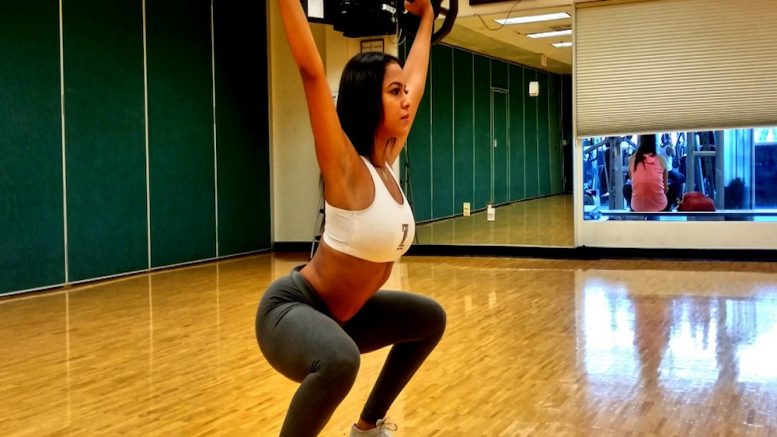Nihat Strider/Staff Writer
This week´s Fitness Model is Saskia Guilbaud, a freshman architecture major. Guilbaud spends a lot of her time in the architecture studio on MMC campus but she makes sure to dedicate time for exercising in between her busy schedule.
The definition of physical fitness can be a little complex as we all have a different idea of what “fit” should look like. For some of us it might mean a sleek, Hollywood style body, while others might want bulging muscles, while a lot of women strive for the hourglass figure.
However, scientists have discovered five components of physical fitness. These components represent a reasonable definition of what a fit and healthy body should be like.
We always hear that exercise is great for you. Undoubtedly, this is true, but in order to get the maximum results from your workouts, you should follow a fitness regime that has variety and is balanced.
This is where the five components of physical fitness are applied.
Cardiovascular fitness
Cardiovascular fitness is the foundation that enhances all other levels of fitness. Cardio refers to the heart and vascular is related to one’s blood vessels leading to and from our lungs.
Cardiovascular exercises efficiently deliver oxygen and nutrients to the working muscles. In other words, it is the capacity of our heart and lungs to work together to supply required oxygen and fuel to our body so it does not suffer through fatigue.
Studies have shown if you perform highly cardiovascular workouts during your exercise, you will have a more efficient heart, lungs and vascular system even when you are at rest. Maintaining this will help people avoid illness and disease, leading to a long and healthy life.
To be honest, any type of rigorous physical activities is cardiovascular exercise. Running is great! But if you do not like running, you can go for a swim, cycle through the neighborhood or even play your favorite sport such as football, basketball or tennis.
Even if you are out on the beach, you can play beach volleyball or go in the water for a swim. If you like group fitness classes, then any form of aerobic exercise will cover your cardiovascular fitness needs.
Muscular Strength
Muscular strength is the opposite of cardiovascular fitness. While cardio is measured over a period of time, muscular strength is measured the highest amount of weight your body can carry in one single repetition.
Muscular strength is power. Power generates the force for a muscle group to accelerate energy. These types of workouts are called anaerobic exercises. For example, all cardio workouts require oxygen as it is over a period of time, whereas an anaerobic workout is the pump you need to produce maximum force.
In scientific terms, muscular strength is the ability of the body’s cells to generate muscle energy in the form of adenosine triphosphate. This component is where weight training comes into play. All the weight lifting done at the gym will significantly increase your muscle strength.
Common workouts to increase muscle strength include squats, bench and leg press, deadlifts and bicep curls.
You need muscle strength for daily living. Imagine just picking up a box, moving your furniture or lifting a bicycle – no matter what you do, you need muscular strength.
Muscular Endurance
Muscular endurance is the hybrid combination of cardiovascular fitness and muscular strength. Do not confuse it with muscular strength. Muscular strength is the maximum amount of force your body can generate in one push, whereas muscular endurance is a measure of how many repetitions your muscles can do and continue to provide energy.
For example, you might be able to squat with 200 pounds, but how many can you do? Your muscles need to have endurance in order to sustain long enough to complete a workout. Imagine going for hike. You have a backpack full of supplies and now you have to climb the mountains, your muscles need energy and endurance in order to make that happen. We all can do a couple of push-ups with the proper form, but we need muscle endurance in order to keep going.
Flexibility
Flexibility is the full range of motion for each of your joints. It is the ability for your joints, muscle groups, ligaments and tendons to move in their maximum range without any hindrance. We often hear of muscle knots, or hypertonicity, as it’s medically referred to, which is due to lack of flexibility of muscles.
Flexibility is very important in our daily lives. In every task we do, every move we make with our bodies, flexibility comes into play. Strong flexibility will protect your joints, bones and muscle groups. Arthritis is one of the biggest consequences of a lack of flexibility workouts in our exercise routines; our joints get very weak and the density of our bones decreases.
You can avoid this by incorporating flexibility workouts into your routine. The use of resistance bands with full range of motion workouts will enhance your flexibility. However, long and proper stretching is extremely effective for flexibility.
Body composition
The final component, body composition, is a great way to measure your physical fitness. Body composition is the percentage of the body´s tissues that are made of fat compared to the tissues that are fat-free. How much you weigh is not important, what your body composition is should be the primary objective.
You have to understand muscle weighs more than fat. When we hear the term lean body mass, it refers to muscles, bones, water and organs inside your body. Try to achieve the ideal body composition in order to be physically fit. A 100 pound person with 30 percent body fat composition means 30 pounds of their total weight is pure fat and the rest 70 percent is lean mass (muscle, bone, organs etc.).
Instead of looking at your scale and getting worried, keep in mind that your body composition is far more important. You can invest in a BMI calculator that will show your body composition. For men, body fat composition should be less than 17 percent, and less than 24 percent for women, to be classified as physically fit.
Next time you work out keep all five components of fitness in mind. If you need help, contact me at life@fiusm.com.
Motivation Monday is a weekly fitness column authored by our staff reporter, Nihat Strider, a fitness trainer at FIU






Fantastic effort to define the complexity of physical fitness. All components are explained in a very healthy way. Specially to focus on BMI calculator for measurement of body composition. I really liked that.